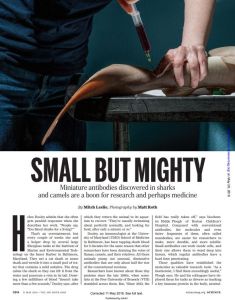Join getAbstract to access the summary!

Join getAbstract to access the summary!
Mitch Leslie
Small but Mighty
Miniature antibodies discovered in sharks and camels are a boon for research and perhaps medicine.
Science, 2018
What's inside?
Antibodies from camels, llamas and sharks have proven useful in the lab. Could they also help human patients?
Recommendation
Camels, llamas and sharks make antibodies smaller than humans’. After being discovered in the late 1980s, they have proven quite useful in the lab. In living organisms, their small size enables these “nanobodies” to bind to molecules and get into cellular spaces that larger antibodies can’t. Mitch Leslie’s article in Science describes a llama antibody’s role in research that was awarded a Nobel Prize – and how nanobodies may help human patients. getAbstract recommends this article to anyone curious about how new technologies get harnessed by researchers and clinicians.
Summary
About the Author
Mitch Leslie writes for Science magazine about cell biology and immunology.


















Comment on this summary